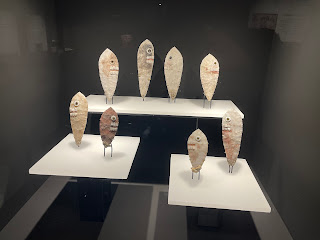The day began in the heart of Mexico City. "Plaza de la Constitución," popularly known as the zocalo (the foundation) has been the center of this urban settlement since prehistoric times.
The ancient temples that stood here for more than a thousand years were reduced to rubble 500 years ago by the Spaniards. They were replaced by a huge cathedral that took 250 years to complete, and by grand palaces that are the home of presidents and bureaucratic offices today.
We saw only the exterior of these edifices during our morning stop, including the balcony from which the President of Mexico delivers the Independence Day address each September 15.
We also walked by some of the excavated ruins of the "Temple Majore" or Grand Temple of the Aztecs.
We also walked by colonial-era buildings that are sinking unevenly into the drained lakebed that once surrounded this plaza.
From Zocalo, our bus drove us to Xochimilco, where some of that original lakebed remains under shallow water. The Spaniards called this place "the Venice of the New World" because the Aztecs -- and even those before them -- had created artificial islands here for agricultural purposes.
Canals between the islands allowed produce to be brought to the city. On this Sunday of a three-day holiday weekend, the canals were crowded with party barges. Mariachi bands moved from barge to barge to provide entertainment.
The band that boarded our barge was dressed in the traditional mariachi costumes, but precise intonation was apparently not a requirement for membership in this group.
There were even small barges loaded with beer, snacks, and other goods for sale, and a simple wave would bring them alongside.
Back on shore, a group of pole climbers, recreating an ancient ritual of coastal tribes, was also eager to collect coins from those who photographed or shot video. Others were selling woven bracelets -- one could buy one with one's name, or others with expressions such as "F*ck Trump." Tariffs don't seem to be popular down here.
After our somewhat chaotic boat ride, the bus took us to the Coyoacan neighborhood (where we had been on our own the first day). We enjoyed an excellent lunch inside the crowded local market. The tour leader had promised the group a drive past the Frida Kahlo Museum, but that didn't materialize. No worries for us, as we'd already been there.
When the bus dropped us back at the hotel, the two of us made a hurried walk back to Zocalo. Again, with the holiday weekend, the streets were packed with people, who all seemed to be walking in the opposite direction we were heading.
The walk was over a mile, but we covered it as quickly as possible because the Temple Majore Museum would close at 5 p.m. We rushed through the outdoor section in the rain, and then continued to rush through the indoor exhibits.
We didn't realize that, although the last entry was at 5, we could remain in the museum until 6 p.m. But rush we did, still catching most of the highlights of what has been unearthed here, despite Spanish destruction.
The rain was even heavier when we departed, but we only went a short distance to the cathedral where we could stay dry. The 5:30 p.m. mass had just begun when we got there, so the main nave was closed. We sat and listened to the service in a narthex area, then got our look.
We walked back to the hotel for some relaxation, but then set out walking once again to the Bellas Artes theater for the 8:30 p.m. Ballet Folklorio. We are really getting our steps today! We had "nosebleed" seats in the very back row of the top balcony. The ballet was quite good, with some excellent Mariachi musicians and really fine dancers. But it was too much of a good thing.














No comments:
Post a Comment